Urgency and Scarcity Marketing
How marketers leverage urgency & scarcity to boost conversions
(Plus 7 ways you can too!)
Picture this: You're back in high school, sitting in one of those daunting exam halls- like the ones where you did your SATs.
Not only do you have pages and pages of exam material left to get through, but the clock on the wall is ominously ticking (you could swear it's going faster than usual), reminding you how little time you have left.
Remember that agitated feeling you'd get every time you looked up to check the time?
That right there, is what we call urgency.
What your teenage self probably didn't know at the time, is that urgency is far more than just a sinking feeling during your finals; it's actually a method that marketers use to influence our behavior and shape our actions all the time.
"Sale ends soon- don't miss out!" and "buy now for speedy delivery" or "hurry, before stock runs out".
We see it pasted across windows and plastered on websites. Countdown timers, calls-to-action, and comments telling us to make a move- or else.
What's it all about?
This article is going to go through the economics and the psychology behind the marketing techniques that we know of as scarcity and urgency.
We'll first look at what they are and how they work. Next, we'll deep dive into the reasons why they work and take a peek at some big businesses who've made these methods work for them.
Lastly, we'll give you some simple, actionable ideas on how you can use scarcity and urgency to your advantage and take your own online business' operations to the next level.
What is urgency?
Urgency is a feeling, a perception that starts in a buyer's mind when they feel as though they need to take quick action.
Certain situations ignite a sense of urgency better than others:
- When time is running out or there's a looming deadline
- When there's limited availability to take part in something
- When stock is low
- When lots of people want the same thing (and there's not enough to go around)
What do all of these scenarios have in common? Something economists call scarcity.
Okay, so what's scarcity?
Scarcity is an economic term that refers to a situation where demand is higher than supply, which would (or could) lead to a shortage of something.
Scarcity is one of the most powerful ways of creating a sense of urgency.
Marketers know how effective it can be to leverage scarcity and urgency when trying to influence buyer behavior. If implemented correctly, buyers will feel like they need to act quicker, make decisions faster, and most importantly- purchase now.
Why else do marketers use urgency and scarcity?
Because these techniques are incredibly good at focusing consumer's thoughts and spurring them into action, marketers regularly use them to achieve a whole smorgasbord of goals, like increasing click-through rates, email open and response rates, conversion rates; multiplying the power of other marketing tools like discounts and sales, and ultimately compelling users to make a purchase.
Phew, that's a mouthful.
Now that we've got the basics nailed down, let's take a look at how urgency and scarcity affect consumer psychology:
How scarcity and urgency affect consumer psychology
Most of the time, when we're talking about scarcity and urgency in practice, we're talking about how they play on people's natural fear of missing out.
Yup, that's the truest nugget of wisdom you'll ever hear:
Urgency is all about the FOMO (Fear of Missing Out).
Here's a breakdown of how urgency and scarcity affect buyer's psychology:
- It creates a feeling of being rushed or running out of time
- Induces stress, since you're now facing an imaginary deadline
- Creates a sense of anticipation
- Tends to speed up the decision making process
- Induces fear of losing out on getting the thing you want (or even worse: losing it to someone else)
The bottom line?
Scarcity and urgency encourage consumers to take action now, rather than later.
Real examples of successful businesses leveraging scarcity & urgency
1. Groupon
If there's any company in the world that know how to truly leverage these techniques, it's Groupon. In fact, their entire business model is built on the premise of scarcity and urgency.
Take this product page, for example:

Not only have they indicated that the product is "selling fast!" and that they've given you an "extra $3 off"; they've even placed a countdown timer right on top that shows you when the sale is ending.
In addition, the top of the page sports a big black and pink banner letting people know about an upcoming sale. This acts as a reminder that products are going to be in high demand and selling fast, so if you want something, you better be prepared to make a move.
2. Booking.com
The hotel booking behemoth is master of creating a sense of urgency. Search for a location and you'll be met with a slew of properties that are "in high demand!" and have been "booked X amount of times in the last 24 hours"- a not-so-subtle reminder that others want what you want.
On top of that, many of the property pages will tempt you into quicker action by letting you know how many people are looking at the property at that very moment. For many, the fear of losing their chance to book a room is enough motivation to make a fast decision.
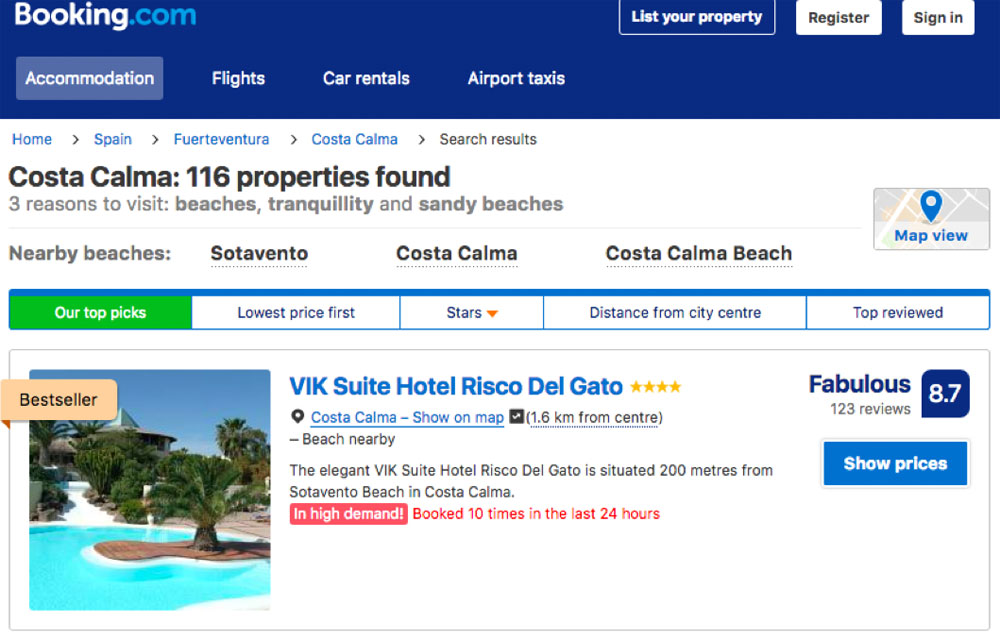
Now, it's worth noting that this works on Booking.com because the numbers they use are believable. There are plenty of examples of websites I've visited that try to use this technique but end up going way overboard ("Gina from Croatia just booked a double room!" isn't convincing anyone).
Remember: leveraging scarcity and urgency only works if it's done in a legitimate way (more on that later).
3. Asos
Go on the Asos website at any time of year and you'll see that their homepage is constantly plastered with banners, countdown timers, and slogans designed to urge their customers into action.
And guess what? It works.
This is what their homepage looks like right now:

The bright pink overhead banner reminds us that it's the "last chance" to avail of their massive 70% off sale.
Simply using buzzwords like this in your web copy can be insanely effective at boosting conversion rates (most likely, the pink color choice helped, too. If you're interested in learning more about the psychology of color on conversion rates, I highly recommend reading this post by marketing guru Neil Patel).
4. Dune
Here's another excellent example of a renowned clothing brand using the power of a countdown timer to encourage their customers to convert.
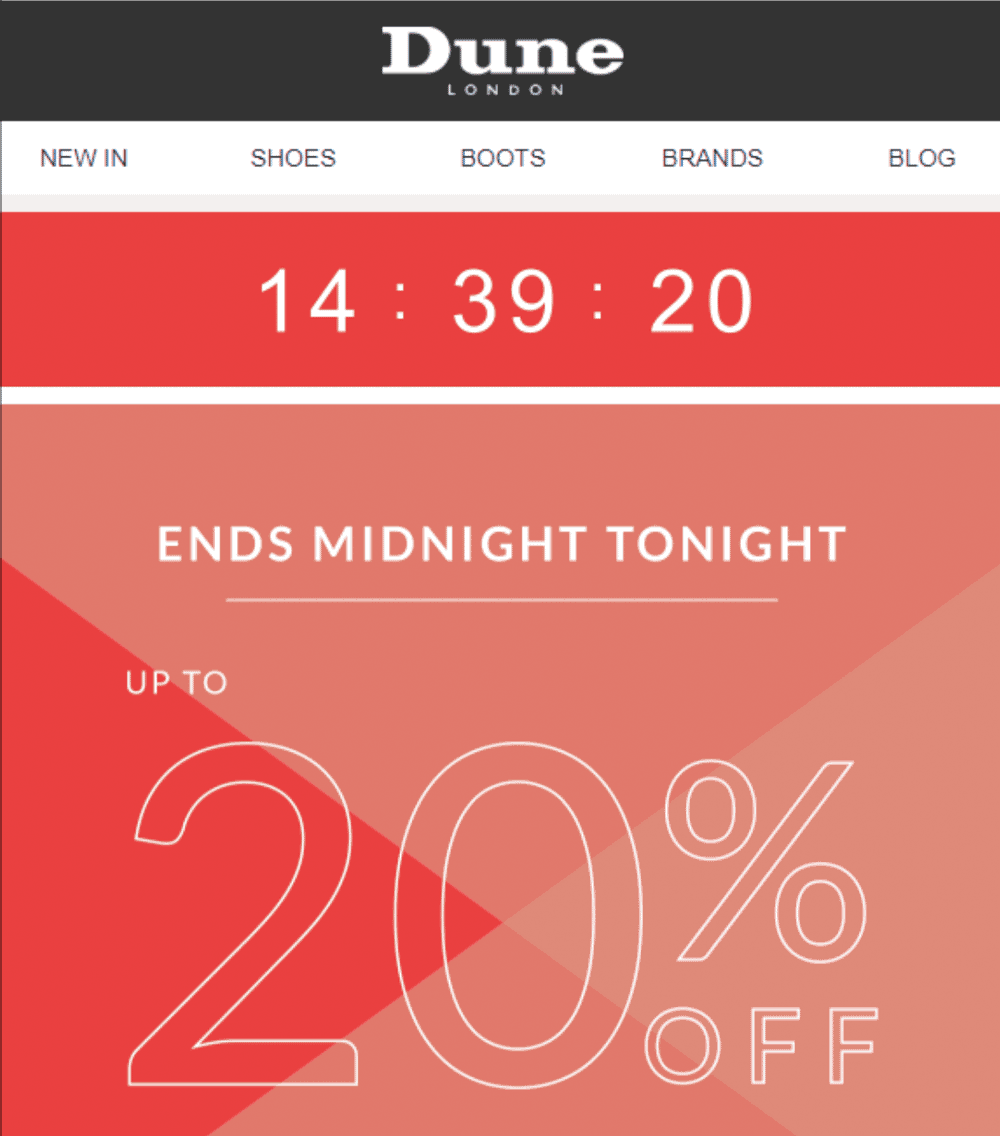
Not only does the timer create a sense of urgency, but the message is also a valuable reminder of the time that the sale will be ending- information that is surely important to Dune's customers.
5. Amazon
Amazon's "buy now with one click" button is a genius way of showing their customers that they've gone to 'extra lengths' to make the buying process as simple and fast as possible.
On top of that, they go on to reward any customer that buys within a given timeframe (in this case, 36 minutes) with free delivery, which adds even more perceived value to the customer.
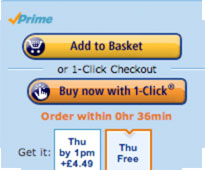
6. Wish
Shopping on Wish.com is a bit like what I imagine it's like to be stuck inside a pinball machine. Bright, loud, and hard to find your way out.
That said, they are pretty darn good at maximizing the effectiveness of scarcity. Flicking through the search results page, you'll see plenty of items that are "almost gone"- a good motivator to buy it now, before they run out.
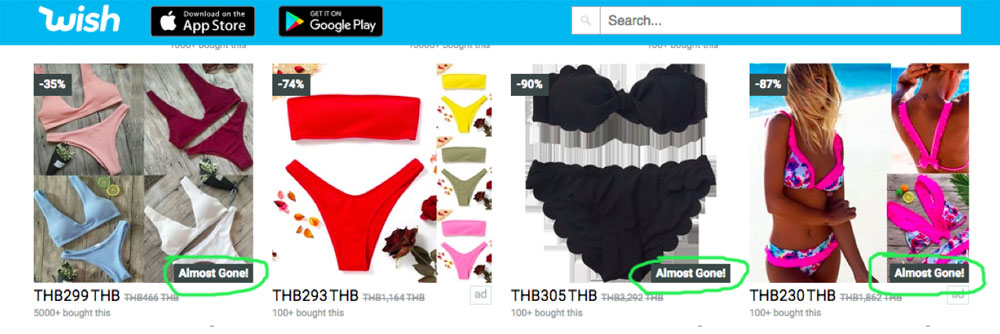
7. Ryanair
Airlines are some of the biggest adopters of scarcity tactics. From British Airways to Emirates, everyone's at it in some way or another.
Here, Ryanair are letting their customers know that only a certain amount of seats are still available at the given price. In their customer's minds, buying now will ultimately save them money, which is a surefire way to boost conversion rates.
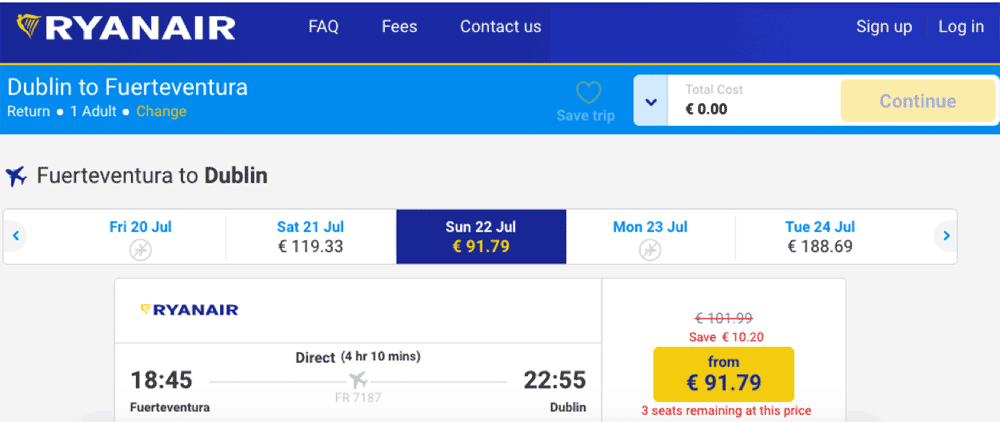
Use urgency to grow your own business
Now, it's not just big businesses that can use these tactics. Anyone can learn to leverage scarcity and urgency to kickstart sales and grow their business' operations.
Tips for using scarcity and urgency to grow your online business:
- Use countdown timers: Whether it's a countdown timer in your next email to boost CTR or a clock on your homepage to indicate the start of a new sale, countdowns are a powerful way to grow anticipation and create a sense of exclusivity.
- Low stock warnings: When business is conducted online, your customers can't see how many products are left on the shelves. Give them a sense of the overall demand for a product and encourage them to buy now when stocks are running low.
- Delivery guarantees when you buy within X amount of time: From offering free delivery to promising the package will make it there before Christmas, delivery guarantees are a great way to create more value for your customers with virtually no extra expense on your side.
- Checkout before discount expires: Offering discounts for a limited period of time and reminding your customers that time is running out is an extremely powerful way of urging them to checkout faster.
- Put a limit on availability: This is particularly effective if you're offering services; let your audience know that there are only "5 spaces left" in your coaching seminar, or that you'll only be accepting "200 applications this month". This creates an appearance of exclusivity and reminds your customers that they definitely do not want to miss out on a spot to someone else.
- Use power words in your web copy: Words like 'now', 'instant', 'limited time', 'hurry', and 'today' are all extremely effective at boosting conversion rates.
- Always offer something of value: When it comes to leveraging scarcity and urgency, it pays to do so in an ethical way. If you're constantly advertising a closing down sale but you never actually intend to close down, your customers are going to catch on pretty fast- and you'll run the risk of losing their trust and loyalty. Provide value, offer transparency. For example, let them know when the sale will end, or when stocks are actually low.
Have you seen other examples of businesses leveraging scarcity and urgency? Got any tricks that have worked for you? Let us know!
